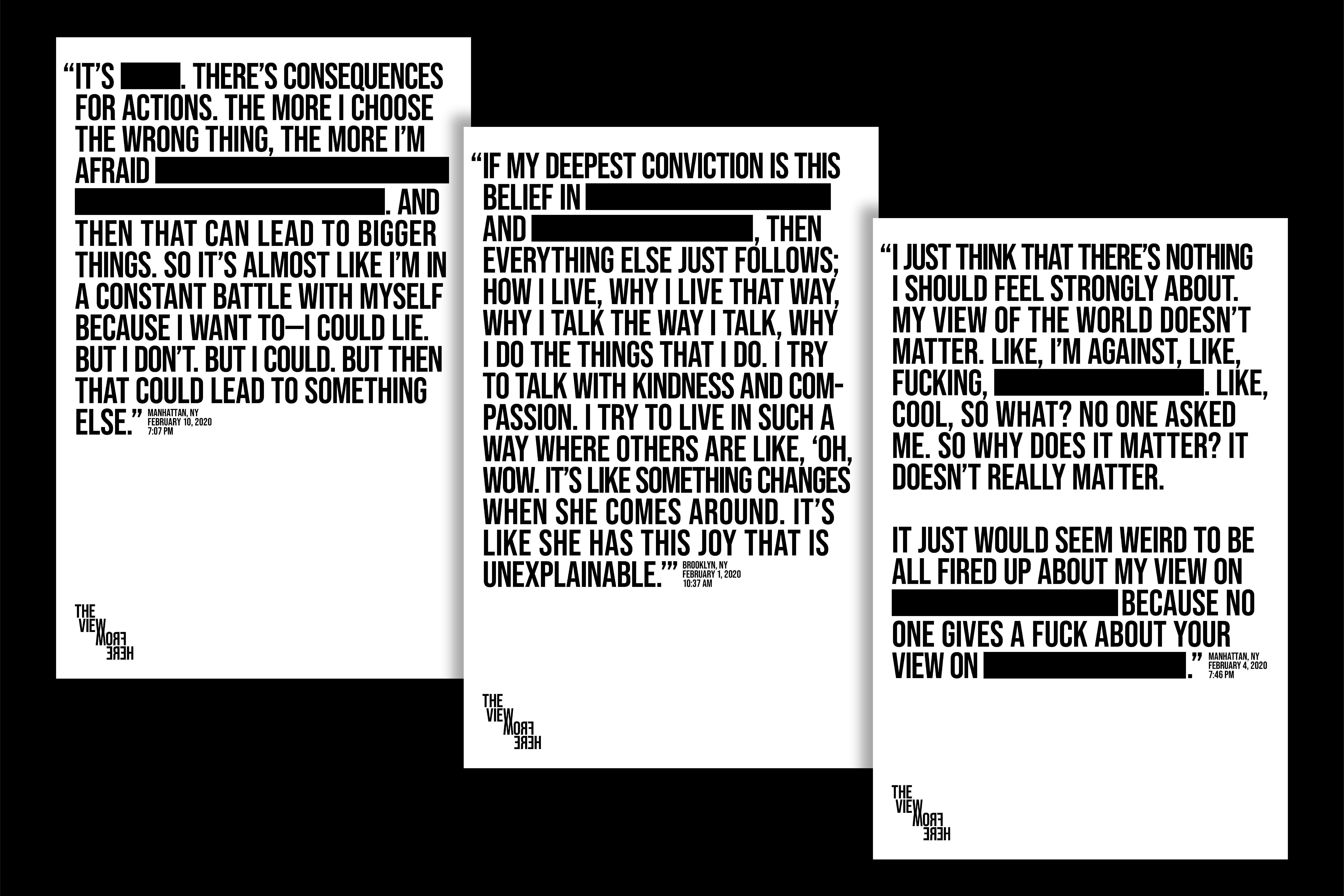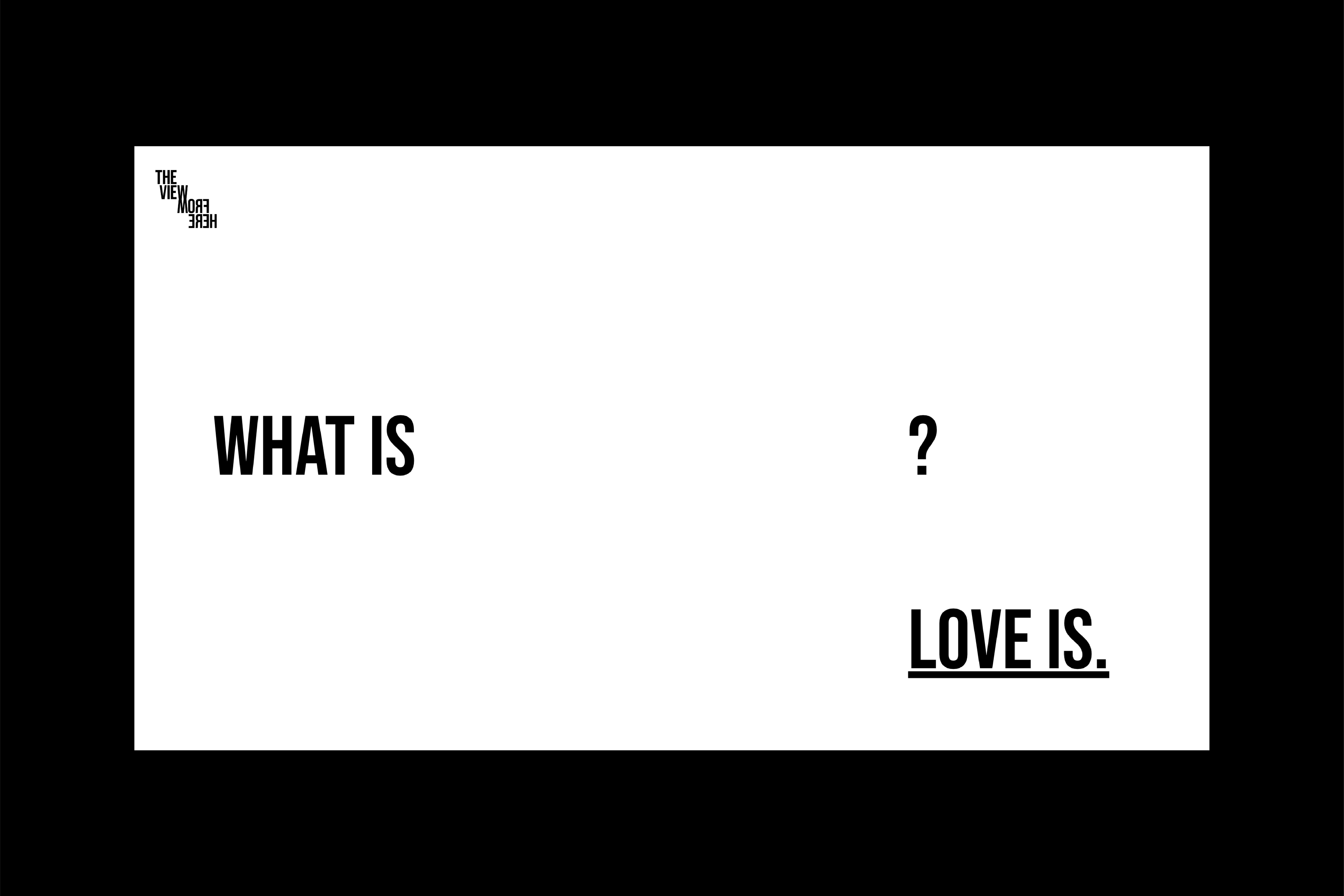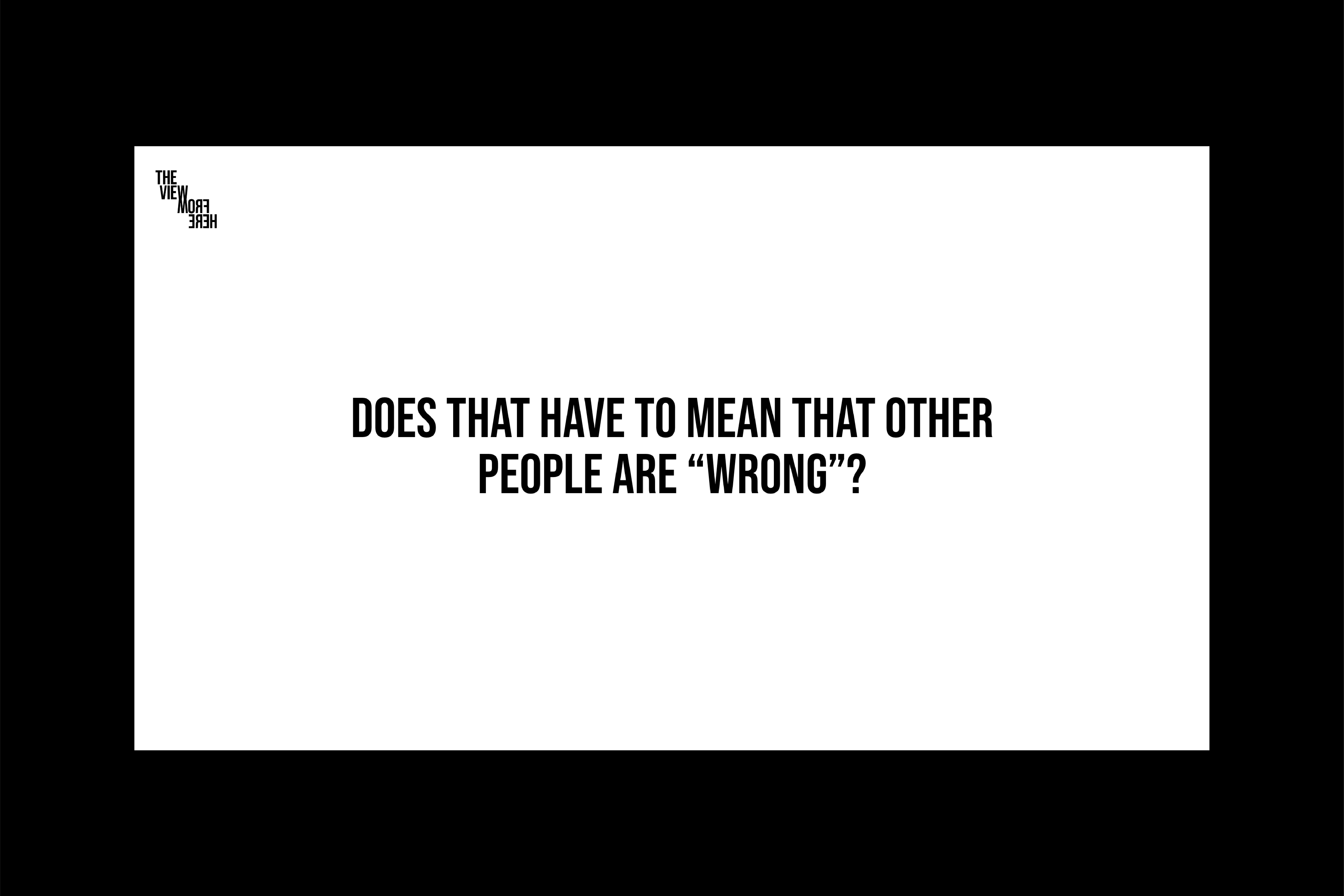The View From Here
HTML, CSS, JSON, PHP, InDesign, Illustrator, XD
Apparently, we can’t all just get along. For every one of the seven billion people in this world, there are just as many different perspectives, built by every experience we have. As experiences compound, we choose what we believe in, and then we spend the rest of our lives seeking out justifications and rationalizations for those beliefs, all the while separating our unique worlds from those of everyone else, until we come to the conclusion that we, individually, are ultimately right, making everyone else ultimately wrong.
It’s the human condition, closed-mindedness has to be written in our genetic code somewhere. But if we could manage to look past the specific positions that we hold, we would find that the reasons we, collectively, believe what we do are typically pretty similar, even if those beliefs are worlds apart.
The View From Here examines a collection of unique perspectives and then redacts them, removing the polarizing elements and thus the “rightness” (or “wrongness,” depending on where you’re standing) from them. Through a series of posters, an interactive webpage, and an online introspective experience, the project illustrates that while we may not be able to easily understand one another, we can certainly learn to respect each other.
![]()
HTML, CSS, JSON, PHP, InDesign, Illustrator, XD
Apparently, we can’t all just get along. For every one of the seven billion people in this world, there are just as many different perspectives, built by every experience we have. As experiences compound, we choose what we believe in, and then we spend the rest of our lives seeking out justifications and rationalizations for those beliefs, all the while separating our unique worlds from those of everyone else, until we come to the conclusion that we, individually, are ultimately right, making everyone else ultimately wrong.
It’s the human condition, closed-mindedness has to be written in our genetic code somewhere. But if we could manage to look past the specific positions that we hold, we would find that the reasons we, collectively, believe what we do are typically pretty similar, even if those beliefs are worlds apart.
The View From Here examines a collection of unique perspectives and then redacts them, removing the polarizing elements and thus the “rightness” (or “wrongness,” depending on where you’re standing) from them. Through a series of posters, an interactive webpage, and an online introspective experience, the project illustrates that while we may not be able to easily understand one another, we can certainly learn to respect each other.

This project ran on caffeine and curiosity. I started with the interviews. I chatted with about a dozen people, for about an hour a piece, about what drives them to be the way that they are, mostly just because I wanted to know who they thought they were. Admittedly, I didn’t know then what I was going to do with these interviews, but when I saw how willing these people were to speak so candidly with me, I was inspired. I thought I had to concoct a grand project to get people to tell me about themselves, but really all they needed was an active listener.
![]()
Through the process of transcribing their words, I came to realize that a lot of these people were talking about the same thing. Some of the participants were Christians, others were Atheists. Some of them were far left, others were conservative. But regardless of which belief they were defending, most all of their explanations boiled down to trusting in something greater than their own experience, and a lot of them were speaking about love. I thought that if we could all listen a little closer to our peers, and maybe redact the specific polarizing points that we disagree with, maybe we could find some common ground. I visualized this by presenting their experiences without the specifics of their beliefs using InDesign.
![]()
With this lens, I tried another approach. I spoke with some more people, this time something between 50 and 100, about how they define “love.” These responses ranged even more broadly. Some people spoke about romantic love, others about the love they have for their hobbies. This was another “aha!” moment for me. I figured that the reason we had a difficult time loving people that we don’t agree with is because we all have different definitions of the word and different experiences of the feeling. I compiled all of this data into a crowd-sourced web experience.
Using XD to prototype, and HTML, CSS, JSON + PHP to finish, I created a platform that first described all of these different interpretations, and then later revealed what they were specifically describing, at which point the user could add their own interpretation of the word.
![]()
Towards the end of this project, I was still struck by how easy it was to get people to open up to me if I only approached them with an open mind. Many of the interviewees, in fact, reached out to me after the fact to thank me for giving them an opportunity for introspection--they felt stronger and more secure in their beliefs after articulating them, and gentler towards those they disagreed with because of this security. I wanted a way to present this experience to even more people.
Of course, I couldn’t travel around and interview hundreds of individuals, so initially I intended to hold a workshop. This brings us to March 2020. As with everything else in the world, this workshop transitioned to online. To make this transition, I used XD for prototyping and HTML + CSS to create.
I analyzed my own portion of the original interviews and found the questions that produced the most thoughtful answers. I presented these questions, one by one, on a simple web page so that the user could investigate their beliefs privately. I hope that the layer of privacy provided by the internet (the absence of another person) encourages users to be even more honest with themselves, but I also think that another person being in the room might ultimately have encouraged them to stay on track and helped to string together common themes.
![]()
Hard to say, though. What do you think?
![]()

Through the process of transcribing their words, I came to realize that a lot of these people were talking about the same thing. Some of the participants were Christians, others were Atheists. Some of them were far left, others were conservative. But regardless of which belief they were defending, most all of their explanations boiled down to trusting in something greater than their own experience, and a lot of them were speaking about love. I thought that if we could all listen a little closer to our peers, and maybe redact the specific polarizing points that we disagree with, maybe we could find some common ground. I visualized this by presenting their experiences without the specifics of their beliefs using InDesign.

With this lens, I tried another approach. I spoke with some more people, this time something between 50 and 100, about how they define “love.” These responses ranged even more broadly. Some people spoke about romantic love, others about the love they have for their hobbies. This was another “aha!” moment for me. I figured that the reason we had a difficult time loving people that we don’t agree with is because we all have different definitions of the word and different experiences of the feeling. I compiled all of this data into a crowd-sourced web experience.
Using XD to prototype, and HTML, CSS, JSON + PHP to finish, I created a platform that first described all of these different interpretations, and then later revealed what they were specifically describing, at which point the user could add their own interpretation of the word.

Towards the end of this project, I was still struck by how easy it was to get people to open up to me if I only approached them with an open mind. Many of the interviewees, in fact, reached out to me after the fact to thank me for giving them an opportunity for introspection--they felt stronger and more secure in their beliefs after articulating them, and gentler towards those they disagreed with because of this security. I wanted a way to present this experience to even more people.
Of course, I couldn’t travel around and interview hundreds of individuals, so initially I intended to hold a workshop. This brings us to March 2020. As with everything else in the world, this workshop transitioned to online. To make this transition, I used XD for prototyping and HTML + CSS to create.
I analyzed my own portion of the original interviews and found the questions that produced the most thoughtful answers. I presented these questions, one by one, on a simple web page so that the user could investigate their beliefs privately. I hope that the layer of privacy provided by the internet (the absence of another person) encourages users to be even more honest with themselves, but I also think that another person being in the room might ultimately have encouraged them to stay on track and helped to string together common themes.

Hard to say, though. What do you think?



